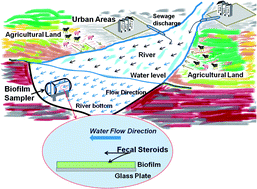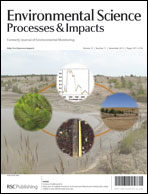Evaluation of potential sewage contamination by fecal sterol biomarkers adsorbed in natural biofilms
Abstract
The use of biofilms for adsorption of sterols was investigated for the first time to evaluate sewage contamination in the Barigüi River, Curitiba (Brazil). The characteristics of a biofilm that favor its use in monitoring include the relatively rapid development of biofilms and their capacity to sorb hydrophobic compounds. Some fecal sterols considered to be biomarkers for human and animal feces have relatively high octanol–water partitioning coefficients (log KOW); thus, sterols were expected to be readily sorbed in the biofilms. The biofilms were developed on glass plates (0.48 m2) previously coated with a fine layer of stearic acid and supported by a PVC tube that was submersed in the river 20 cm above the river bottom. After a certain period of incubation time, the biofilm growth was scraped from the plates and analyzed for the following fecal steroids: coprostanol (5β-cholestan-3β-ol), epicoprostanol (5β-cholestan-3α-ol), cholesterol (5,6-cholesten-3β-ol), cholestanol (5α-cholestan-3β-ol), stigmastanol (24β-ethyl-5α-cholestan-3β-ol) and coprostanone (5β-cholestan-3-one). Six samples were collected between March 2012 and June 2012. All analyzed compounds were detected, and in general, cholesterol was present in high amounts (23 160–41.9 ng g−1 dry biofilm). Variation among campaigns was observed in the distribution of sterols, with cholestanol showing the least variation among the samples. Sterol ratios that are commonly used for evaluating sewage contamination were calculated; these ratios indicated some periods of potential sewage influence. However, these sterol ratios are intended to be applied primarily for sediments and not for biological compartments; thus, the results must be carefully interpreted. Biofilms developed under natural conditions can be a tool for monitoring some important sterols that are used as biomarkers of fecal pollution.


 Please wait while we load your content...
Please wait while we load your content...